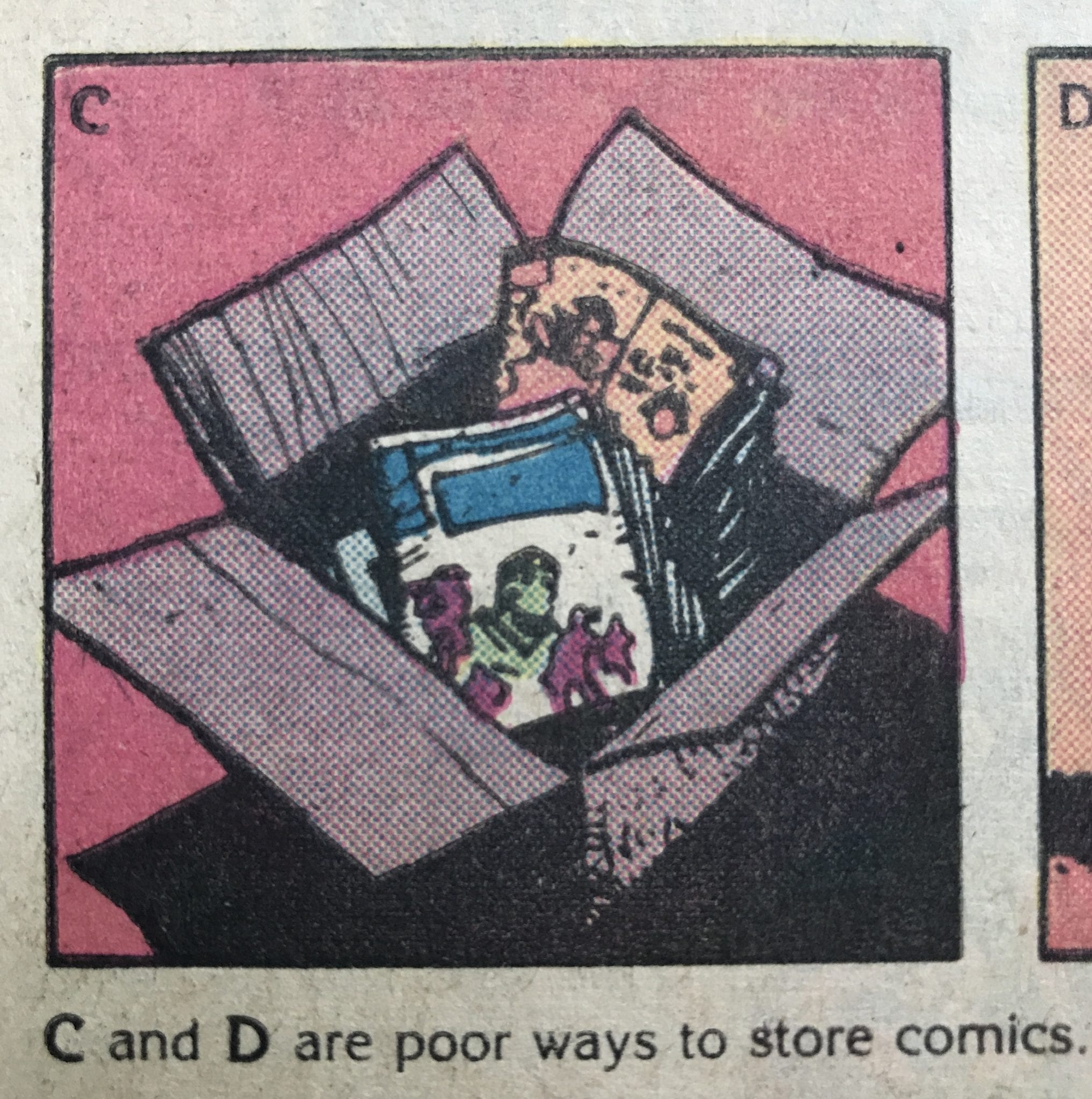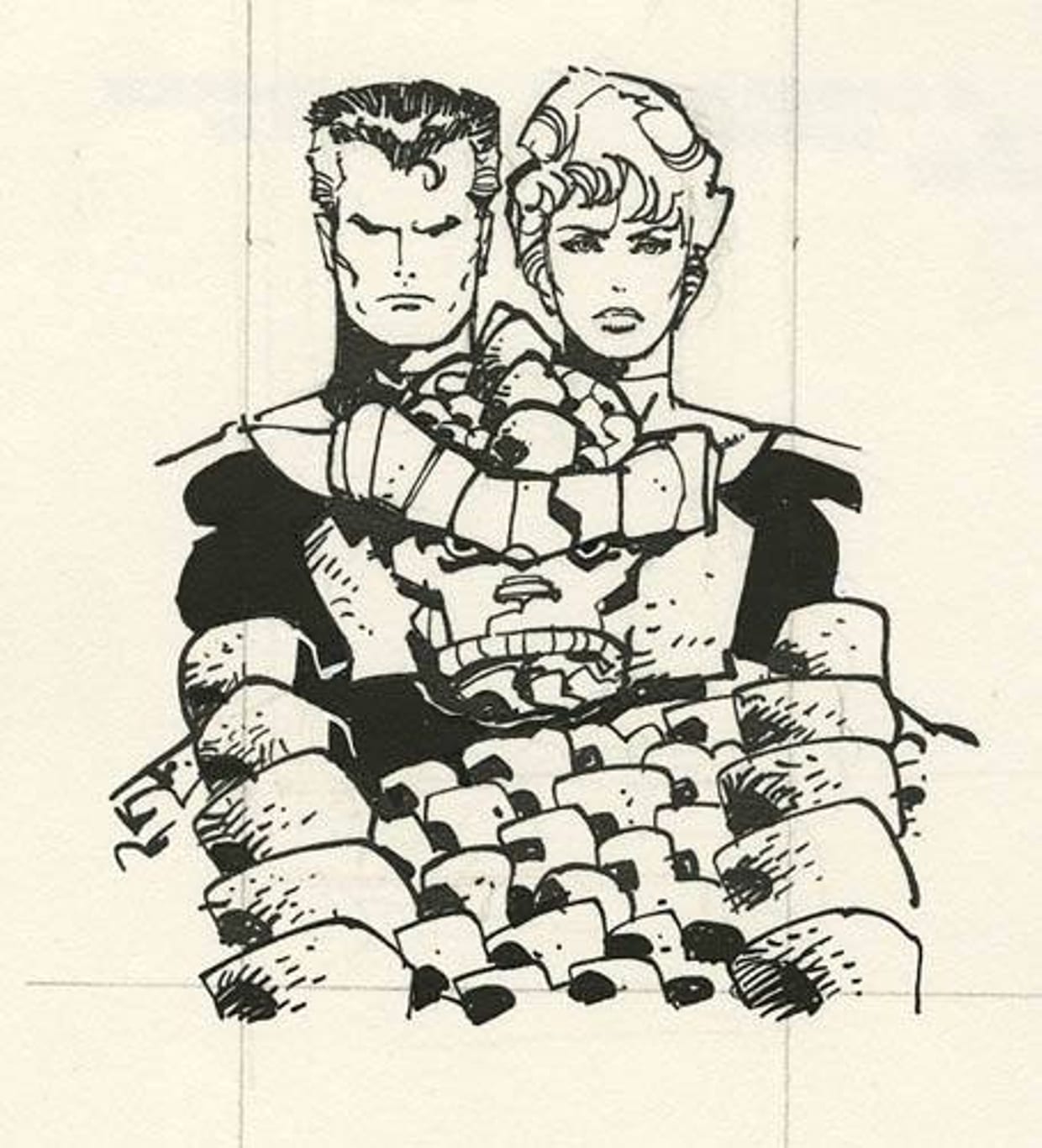I've gone on and on about the work of Walter Simonson before and how much it has influenced me since my formative years as a cartoonist. The very first Simonson comic I bought and owned and read was an issue of Fantastic Four. It wasn't the "real" kick-off to his run, though, it was a crossover fill-in issue, #334. It was the cover that attracted me; here it is sans logo:
I'm known in my neighborhood as the local Acts of Vengeance apologist, so I have a soft spot for Walt's 3-issue long association with it.
Something about it kept me coming back, because I was there when his official, for real for real, debut issue dropped, #337. I picked that up and never looked back. (Notice Thor's blue shirt with a tiny "x" in the middle, an area ready to be filled with black ink.)
So let me just briefly tell you that Walt Simonson's all-too brief run on this title is not only some of the best Marvel Comics ever but also some of his most inspired material. He is not fucking around here, folks. I'll let the pictures do most of the talking.
That double page splash spread--! Good lord, man. "Look what I drew, Weezie, just another masterpiece. What do you wanna have for dinner tonight?" That one's dedicated to the "Doctor of Flash -- Mr. Howard Chaykin" by the way.
[Special shout out to all the men and women who lettered, colored, edited, and sometimes even inked this run of comics: Bill Oakley, Todd Klein, John Workman Jr., Christie Scheele, Steve Buccellato, Brad Vancata, Marie Javins, Renee Witterstaetter, Ralph Macchio, Art Thibert, Al Milgrom.]
This storyline traffics in time travel, and the visual language that Simonson assigns this adventure is nothing short of innovative. Look at this layered, clear, kinetic approach to take-off:
In the next issue, turbulence broken up:
Fans and pros go apeshit over this following double page spread, but it's never enough people, is it? I want the entire world to jump out their windows in joy whenever they see stuff like this:
If you can pull off this type of shortcut and have it serve the story, you win, pal. Zero complaints:
Let's examine this three-page sequence:
The symmetry of the scene features the decompression of panels up front, chaos in the middle, and the regrouping/tightening of panels at the end. All the while there are larger images dominating the backdrop of the page, behind/between the panel borders. This perfectly captures the scope of what the characters are dealing with.
Another memorable sequence is the Ultimate Nullifier being used for the very first time. What's that look like, you ask?
Yes, that is the world's best shortcut for an artist, but it is an earned moment in the story. Just pretend Dick Tracy isn't there.
Johnny Storm's never looked cooler. Guns make everything cooler:
I love when Simonson draws smaller gestures, like people in regular clothes just standing around. This top middle panel does it for me. Then of course he throws in a huge prehistoric landscape shot that reminds me more of Bill Watterson than anything else:
Simonson only wrote this Arthur Adams-drawn chunk, but man, these are just good-ass comic books:
Here's an ultra rare moment of Simonson's meta snark:
Another layered sequence: a power-specific & story-propelling innovation:
This is a big one. Two different timelines presented simultaneously. The bar on the right is inked with what looks to be Dou-Shade, instantly setting it apart. That strip is told out of order in a random assortment, since the participants of the fight are time hopping. Things get even more interesting...
...when the timelines mingle even for just a moment. If this doesn't blow you away, you're dead inside:
Separated at birth:
Great design to display a garbage bin of nothingness. Note: the character giving the tour was modeled after Mark Gruenwald. This comic dares me to not love it. Cameos by Supergirl and I believe that horse-headed Power Pack character:
Excellent speed, momentum, and impact:
Simonson cited Katsuhiro Otomo as an influence early on in his FF run. I sort of see it in bits and pieces, but something about this page sells it the most even though it's mostly superficial aspects (speed lines, double panels cut diagonally):
Before he exits, Simonson cranks it up and goes out punching. Drink in this ingenious way time is warped and disjointed, never at the expense of clarity. Simple, effective, and it visually loops back to the take-off page. The Judge Dredd analogue doesn't hurt, either:
"Simonson once described comics as illustration with the addition of time." said Howard Chaykin, "That's a much more complex remark than it appears."
That's the perfect coda to this entire time traveling saga. It's a narrative best told in comics, as Simonson bends time and plays with the rules of static imagery.
Here's a suggested reading order of Walter Simonson's Fantastic Four comics:
· #212 (Cover only, and it is worth the price of admission alone.)
· Marvel Age #80 (Great cover, great article.)
· #s 334-336 (Stories & Covers by Walt, and I'm usually a sucker for the Acts of Vengeance event, but these don't really gel with the rest.)
· #s 337-341 (How To Start An Epic Story 101.)
· #s 343-346 (These work just as well as a couple of self-contained two parters.)
· FF Annual #23 (Walt wrote it, but it's a square peg, this one. Easy skip.)
· #s 347-349 (A classic example of asking what the artist wants to draw and taking it from there.)
· #350, 352-354 (The grand finale!)
Notes on the collected editions of these comics:
· FF Visionaries Walter Simonson Vol. 1-3 - If I remember correctly, this one had decent back matter but it included a pin-up drawn by Simonson-clone Tom Morgan, who also drew a page in the fill-in issue. (#342, which was also included in the collection even though Simonson had nothing to do with the issue.) All this would be fine if the theme and title of the book weren't dedicated to a specific artist.
· FF Epic Collection: Into the Timestream - This collection also includes that #342 fill-in and the entire connected crossover that went along with that year's FF Annual which barely relates to the rest of Walt's run. Additionally, one of these editions (maybe both) printed only half of the blank double page spread we saw earlier, thus diminishing the intended effect.
This relentless lack of attention to detail is disheartening. But the issues still exist at least. These comics are cheap and available, so raid your bins, download the apps, or read between the lines.
Plenty of love and recognition from fans and pros alike is directed at Walt Simonson... but like I said, it's not enough, and not nearly enough for the right reasons. Ok, so "Uncle Walt" draws cool Thor stuff and he's the industry's Nicest Guy - those are the broad strokes - but he's primarily one of comics' greatest thinkers and has been for decades. Decades. This isn't a brief bout of beginner's luck or mid-career brilliance. His consideration within the scope of storytelling is highly measured and his skills as an artist are dizzying. Combined, they form a vision that transcends "cool drawings" or "well executed stories".
Simonson hasn't been studied or discussed with the same rigor dedicated to his peers Chaykin, Miller, and Moore. It's odd, considering Simonson applies the same level of craft and thought to his work, if not more, than those giants. One might incorrectly conclude that Simonson never toils in the realm of the Deeply Personal, perhaps making it easy for "scholars" to brush his work aside. Consider this: his interest in history, mythology, and sci-fi are indeed fuel for his profound expression. If you follow that train of thought, it'll be easier to see and accept why some of his best works were for corporate properties - a system of labor that held the keys to characters through which he could explore his interests and play with the form while making a living. "Creator-owned"... sure, that's nice, but Jack Kirby creations seem to be the most powerful conduits for Simonson's personal vision. There's a clear buzz when he's been working on specific titles; compare his THOR to his X-Factor, ORION to any job he did before and after, or compare everything you've seen above to anything going on then or going on now, with anyone.
Walt Simonson's Fantastic Four run is the work of a master. I suspected as much when I first grabbed it off the rack, Acts of Vengeance be damned.
This article first appeared in Michel Fiffe's Patreon page.







































